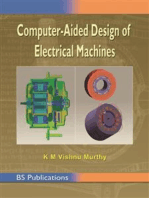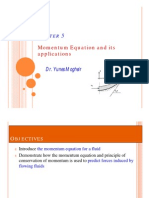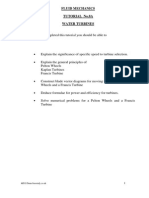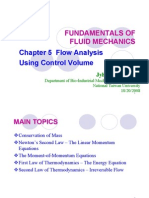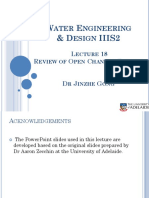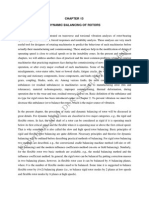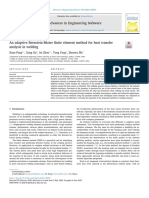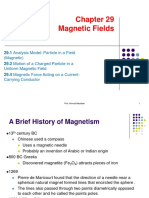Wecs
Wecs
Uploaded by
Rajaraman KannanCopyright:
Available Formats
Wecs
Wecs
Uploaded by
Rajaraman KannanOriginal Description:
Original Title
Copyright
Available Formats
Share this document
Did you find this document useful?
Is this content inappropriate?
Copyright:
Available Formats
Wecs
Wecs
Uploaded by
Rajaraman KannanCopyright:
Available Formats
PS 9155 WIND ENERGY CONVERSION SYSTEMS
By
krr
Components of WECS-WECS schemes-Power obtained from wind-simple
momentum theory-Power coefficient-Sabinins theory-Aerodynamics of Wind
turbine
2
1. simple momentum theory
2. Aerodynamics of Wind turbine
3. Bernoulli Equation
4. Betz Law
5. Power coefficient
6. Sabinins theory
Padmanathan K
Research Scholar
3
Padmanathan K
Research Scholar
4
Padmanathan K
Research Scholar
5
Aerodynamics-Basics
Newtons Laws of motion:
A. Law 1 A body at rest will remain at rest. A body
in motion will remain in motion
B. Law 2 F=MA Force is equal to mass times
acceleration
C. Law 3 For ever action there is an equal and
opposite reaction
Bernoullis principle of Pressure:
An increase in the speed of movement or flow
will cause a decrease in the fluids pressure.
- Example: the Venturi tube
Low Pressure
Padmanathan K
Research Scholar
7
Wind turbine farms are being
constructed all over the world to extract
kinetic energy from the wind and convert
it to electrical energy. The mass, energy,
momentum, and angular momentum
balances are utilized in the design of a
wind turbine. The Bernoulli equation is
also useful in the preliminary design
stage.
MASS, BERNOULLI AND ENERGY EQUATIONS
8
Objectives
Apply the conservation of mass equation to
balance the incoming and outgoing flow rates in
a flow system.
Recognize various forms of mechanical energy,
and work with energy conversion efficiencies.
Understand the use and limitations of the
Bernoulli equation, and apply it to solve a
variety of fluid flow problems.
Work with the energy equation expressed in
terms of heads, and use it to determine turbine
power output and pumping power requirements.
Momentum Theory -Overview
In this module, we will study the simplest
representation of the wind turbine as a disk across
which mass is conserved, momentum and energy are
lost.
Towards this study, we will first develop some basic
1-D equations of motion.
Streamlines
Conservation of mass
Conservation of momentum
Conservation of energy
Padmanathan K
Research Scholar
9
Motion of fluid
energy kinetic
Pressure in fluid energy
potential
KE + PE is constant
Bernoullis Equation: derivation
Consider a volume AV of mass AM of incompressible fluid,
AKE =
1
2
Mv
2
2
1
2
Mv
1
2
=
1
2
AVv
2
2
1
2
AVv
1
2
APE = Mgy
2
Mgy
1
= AVgy
2
AVgy
1
W = F
1
Ax
1
F
2
Ax
2
= P
1
A
1
Ax
1
P
2
A
2
Ax
2
= P
1
AV P
2
AV
P
1
+ gh
1
+
1
2
v
1
2
= P
2
+ gh
2
+
1
2
v
2
2
Padmanathan K
Research Scholar
12
Consider a stream tube, i.e. a collection of streamlines
that form a tube-like shape.
Within this tube mass can not be created or destroyed.
The mass that enters the stream tube from the left (e.g.
at the rate of 1 kg/sec) must leave on the right at the
same rate (1 kg/sec).
Padmanathan K
Research Scholar
13
Padmanathan K
Research Scholar
14
Area A
1
Density
1
Velocity V
1
Area A
2
Density
2
Velocity V
2
Rate at which mass enters=
1
A
1
V
1
Rate at which mass leaves=
2
A
2
V
2
Padmanathan K
Research Scholar
15
Continuity
Padmanathan K
Research Scholar
16
In compressible flow through a tube
AV= constant
In incompressible flow, does not change. Thus,
AV = constant
Padmanathan K
Research Scholar
17
Padmanathan K
Research Scholar
18
AV = constant
If Area between streamlines
is high, the velocity is low
and vice versa.
High Velocity
Low Velocity
Padmanathan K
Research Scholar
19
Continuity (Continued..)
AV = constant
If Area between
streamlines
is high, the velocity is low
and vice versa.
In regions where the
streamlines squeeze
together,
velocity is high.
High Velocity
Low Velocity
Padmanathan K
Research Scholar
20
Venturi Tube is a Device for Measuring Flow Rate
Padmanathan K
Research Scholar
21
Low velocity
High velocity
Bernoullis Principle - Lift
As the velocity of a fluid increases,
its internal pressure decreases.
+From Newtons 2
nd
(F=ma)
+Shown by Venturi tube
Low Pressure
High Pressure
A
1
V
1
=A
2
V
2
Bernoullis Principle
Air is a gas and a fluid
Air pressure is due to the motion of its
particles
Pressure in a moving stream exerts less
pressure than the air surrounding the moving
stream
Quick stream = low air pressure
Slow stream = High air pressure
Padmanathan K
Research Scholar
24
Station 1
Density
1
Velocity V
1
Area A
1
Station 2
Density
2
Velocity V
2
Area A
2
Mass Flow Rate In = Mass Flow Rate Out
1
V
1
A
1
=
2
V
2
A
2
Padmanathan K
Research Scholar
25
Momentum Equation (Contd..)
Density
velocity V
Area =A
Density +d
velocity V+dV
Area =A+dA
Momentum rate in=
Mass flow rate times velocity
= V
2
A
Momentum Rate out=
Mass flow rate times velocity
= VA (V+dV)
Rate of change of momentum within this element =
Momentum rate out - Momentum rate in
= VA (V+dV) - V
2
A = VA dV
Padmanathan K
Research Scholar
26
Momentum Equation (Contd..)
Density
velocity V
Area =A
Density +d
velocity V+dV
Area =A+dA
Rate of change of momentum as fluid particles
flow through this element= VA dV
By Newtons law, this momentum change must be caused by
forces acting on this stream tube.
Forces acting on the Control Volume
Surface Forces
Pressure forces which act normal to the surface
Viscous forces which may act normal and tangential to
control volume surfaces
Body forces
These affect every particle within the control volume.
E.g. gravity, electrical and magnetic forces
Body forces are neglected in our work, but these may be
significant in hydraulic applications (e.g. water turbines)
Padmanathan K
Research Scholar
27
Padmanathan K
Research Scholar
28
Forces acting on the Stream tube
Pressure
times
area=pA
(p+dp)(A+dA)
Horizontal Force = Pressure times area of the ring=(p+dp/2)dA
Area of this ring = dA
Net force = pA + (p+dp/2)dA-(p+dp)(A+dA)=- Adp - dp dA/2~-Adp
Product of two
small numbers
Momentum Equation
Padmanathan K
Research Scholar
29
From the previous slides,
Rate of change of momentum when fluid particles flow
through the stream tube = AVdV
Forces acting on the stream tube = -Adp
We have neglected all other forces - viscous, gravity, electrical
and magnetic forces.
Equating the two factors, we get: VdV+dp=0
This equation is called the Eulers Equation
Bernoullis Equation
Padmanathan K
Research Scholar
30
Euler equation: VdV + dp = 0
For incompressible flows, this equation may be integrated:
Const p V
Or
dp VdV
= +
= +
} }
2
2
1
,
0
Kinetic Energy + Pressure Energy = Constant
Bernoullis
Equation
Actuator Disk Theory: Background
Developed for marine propellers by Rankine (1865),
Froude (1885).
Used in propellers by Betz (1920)
This theory can give a first order estimate of HAWT
performance, and the maximum power that can be
extracted from a given wind turbine at a given wind
speed.
This theory may also be used with minor changes for
helicopter rotors, propellers, etc.
Padmanathan K
Research Scholar
31
Assumptions
Momentum theory concerns itself with the
global balance of mass, momentum, and
energy.
It does not concern itself with details of the
flow around the blades.
It gives a good representation of what is
happening far away from the rotor.
This theory makes a number of simplifying
assumptions.
Padmanathan K
Research Scholar
32
Assumptions (Continued)
Rotor is modeled as an actuator disk which
adds momentum and energy to the flow.
Flow is incompressible.
Flow is steady, inviscid, irrotational.
Flow is one-dimensional, and uniform through
the rotor disk, and in the far wake.
There is no swirl in the wake.
Padmanathan K
Research Scholar
33
Control Volume
Padmanathan K
Research Scholar
34
V
Disk area is A
Total area S
Station1
Station 2
Station 3
Station 4
V- v
2
V-v
3
Stream tube area is A
4
Velocity is V-v
4
Conservation of Mass
( )
4 4
1
4 4 4
A v
bottom at the Outflow top at the Inflow
m side he through t Ouflow
)A v (V A - S V bottom he through t Outflow
VS top he through t Inflow
=
=
=
+ =
=
Padmanathan K
Research Scholar
35
Conservation of Mass through the Rotor
Disk
( ) ( )
( )
4 4
3 2
v
v v
=
= =
V A
V A V A m
Padmanathan K
Research Scholar
36
Thus v
2
=v
3
=v
There is no velocity jump across the rotor disk
The quantity v is called velocity deficit at the rotor disk
V-v
2
V-v
3
Global Conservation of Momentum
( ) ( )
4 4 4 4
4
2
4
2
4
4 4
1
2
v v ) v ( A D
out Rate Momentum
- in rate Momentum D , rotor on the Drag
. boundaries field far the
all on c atmospheri is Pressure
v A - S
bottom through outflow Momentum
v A
V m side he through t outflow Momentum
V op through t inflow Momentum
m V
A V V
V
S
= =
=
+
=
=
=
=
Padmanathan K
Research Scholar
37
Mass flow rate through the rotor disk times
velocity loss between stations 1 and 4
Conservation of Momentum at the Rotor
Disk
Padmanathan K
Research Scholar
38
V-v
V-v
p
2
p
3
Due to conservation of mass across the
Rotor disk, there is no velocity jump.
Momentum inflow rate = Momentum outflow rate
Thus, drag D = A(p
2
-p
3
)
Conservation of Energy
( )
( ) ( )
4
4
3 2
2
4
2
3
2
2
2
v
2
v
v
2
1
v
2
1
2
1
v
2
1
|
.
|
\
|
=
+ = +
+ = +
V p p
V p V p
V p V p
Padmanathan K
Research Scholar
39
Consider a particle that traverses from station 1 to
station 4
We can apply Bernoulli equation between
Stations 1 and 2, and between stations 3 and 4.
Not between 2 and 3, since energy is being removed by
body forces.
Recall assumptions that the flow is steady, irrotational,
inviscid.
1
2
3
4
V-v
V-v
4
( )
4
4
3 2
4
4
2 3
v
2
v
v
2
v
, slide previous the From
|
.
|
\
|
= =
|
.
|
\
|
=
V A p p A D
V p p
( )
4
v v = V A D
Padmanathan K
Research Scholar
40
From an earlier slide, drag equals mass flow rate through the rotor disk
times velocity deficit between stations 1 and 4
Thus, v = v
4
/2
Induced Velocities
Padmanathan K
Research Scholar
41
V
V-v
V-2v
The velocity deficit in the
Far wake is twice the deficit
Velocity at the rotor disk.
To accommodate this excess
Velocity, the stream tube
has to expand.
Power Produced by the Rotor
( )
( )
( )
( ) | |
limit. Betz called is This
power. into converted be may energy inflowing the of 16/27 only best at Thus
27
16
2
1
Pmax
1/3 a : result get the We
0
a
P
set
value, maximum its reaches power when determine To
v/V a where,
1 4
2
V
A
v v
1 4
2
V
A v v 2
v v 2
2v V
2
1
V
2
1
out flow Energy - in flow Energy
3
2
2
2
2
2
2
2
|
.
|
\
|
=
=
=
c
c
=
=
(
(
|
.
|
\
|
= =
=
=
=
AV
a a
V V
V A
V m
m m
P
Padmanathan K
Research Scholar
42
Summary
According to momentum theory, the velocity
deficit in the far wake is twice the velocity deficit
at the rotor disk.
Momentum theory gives an expression for
velocity deficit at the rotor disk.
It also gives an expression for maximum power
produced by a rotor of specified dimensions.
Actual power produced will be lower, because
momentum theory neglected many sources of
losses- viscous effects, tip losses, swirl, non-
uniform flows, etc.
Padmanathan K
Research Scholar
43
Bernoullis Principle Again
Courtesy of FAA: Pilots Handbook of Aeronautical Knowledge, AC 61-23B
Winds over a mountain
Below is a NASA illustration of what
surface pressure is exerted on what
surface areas of the wing.
Bernoullis Principle Again
Courtesy of FAA: Pilots Handbook of Aeronautical Knowledge, AC 61-23B
Bernoullis Principle Again
Courtesy of FAA: Pilots Handbook of Aeronautical Knowledge, AC 61-23B
Lift Vector
Courtesy of FAA: Pilots Handbook of Aeronautical Knowledge, AC 61-23B
Blades
Aerofoil design
Air flow over the blade develops lift force
and causes the blade to rotate
Drag
Induced drag is a by-product of
lift and is greatly affected by
changes of airspeed.
Drag Types
Induced drag is the unavoidable by-product of lift and
increases as the angle of attack increases
Parasite drag is caused by any aircraft surface that
deflects or interferes with smooth airflow around
airplane
+Skin-friction drag - between the outer surfaces of
the aircraft and the air through which it moves.
Reduced by using glossy, flat finishes on surfaces
+Form drag - resistance of air to the shape of the
aircraft. Form drag can be reduced by streamlining
the aircraft shape.
Aerodynamics - Stalls
When does an airplane stall?
When it exceeds the critical angle of attack.
Chord line=the line from the leading edge of the wing to the
trailing edge
Relative wind=perpendicular to lift, relative to the airfoil
What is angle of attack?
Angle of attack is the angle between the chord line and the
relative wind
Basic airfoil terminology
Camber = distance between mean camber line (mid-point of airfoil) and
the chord line (straight line from leading edge to trailing edge)
Thickness = distance between upper and lower surfaces (measured
perpendicular to chord line)
Span = length of airfoil normal to the cross-section
Camber
Thickness
Torque / P-factor (Left-Turning Tendencies)
Newtons 3
rd
law: For
every action there is an
equal and opposite
reaction.
Propeller rotates CW when
viewed from pilots seat.
Torque reaction rotates the
airplane CCW about
longitudinal axis
P-factor (asymmetrical
thrust) caused by
descending blade taking a
greater bite of air than
ascending blade at high
angle of attack
Four Aerodynamic Forces
1.Lift 2.Thrust 3.Drag 4.Weight
The engines provide THRUST.
The wings provide LIFT.
Gravity provides the G force. (weight)
And, fluid friction provides the DRAG.
LIFT
GRAVITY
THRUST
DRAG
Padmanathan K
Research Scholar
60
Lift briefly exceeds weight.
Rearward component of the Lift adds to drag
Upward component of Thrust is called the Lift
of Thrust
Second law of motion says that a force results
whenever a mass is accelerated F = ma
Third law states for every action there is an
equal and opposite reaction
Four Forces of Flight
Lift opposes Weight
Thrust opposes Drag
In straight, unaccelerated flight, L = W & T = D
Lift created by pressure differential around wing. High pressure on lower
surface and low pressure on the upper surface low pressure caused by
increased airflow velocity over top of airfoil.
Weight downward force of gravity
Drag rearward retarding force
Thrust forward force propelling airplane through air
Airfoils
What is NACA?
National Advisory
Committee for
Aeronautics
Chartered in 1915,
operational from
1917-1958
The National
Aeronautics and
Space Act of 1958
created NASA from
NACA
Airfoils - Nomenclature
Chord line - straight line connecting the leading and trailing edges of an airfoil
Camber line locus of all points equidistant from top and bottom of airfoil
Camber distance between chord line and camber line
Thickness maximum distance between top and bottom surfaces of wing
Leading Edge
Trailing Edge
Wingspan (b)
Aspect Ratio (AR = b
2
/S)
Low p
High p
Angle of Attack
Angle between wing chord line and relative wind
The angle of attack at which airplane stalls does
not change
Aerodynamics-Basics
Because air is a fluid, it utilizes the properties
of the Coanda effect: the tendency for a fluid
to follow the object along its flow path.
http://www.youtube.com/watch?v=AvLwqRCb
GKY
http://www.youtube.com/watch?v=S-
SAQtODAQw
krr 66
The power in the wind than can be extracted by a wind turbine is proportional
to the cube of the wind speed and is given in watts by:
where represents the aerodynamic efficiency of the rotor.
-air density,
A- rotor swept area,
U-wind speed
C
p
power coefficient
C
p
- Power Coefficient
C
p
POWER OUTPUT FROM THE WIND MACHINE
POWER CONTAINED IN WIND
= ________________________________________
krr 67
krr 68
Sabinins theory
The main merit of prof. G.H.Sabinin in wind power for ever remain the presence
proved to him so-called the affixed weight as a result of which the greatest
possible part of energy which can be taken from an ideal rotor makes 68,6 %
(instead of 59,3 % on A.Betz). As appeared, almost all world does not know about it
and counts aerodynamics of rotors using the formulas A.Betz. A limit of 59,3 %
name a limit and even law A.Betz
You might also like
- Renewable Energy Tariffs and Incentives in Indonesia: Review and RecommendationsFrom EverandRenewable Energy Tariffs and Incentives in Indonesia: Review and RecommendationsNo ratings yet
- Grid-Integrated and Standalone Photovoltaic Distributed Generation Systems: Analysis, Design, and ControlFrom EverandGrid-Integrated and Standalone Photovoltaic Distributed Generation Systems: Analysis, Design, and ControlNo ratings yet
- Simple Performance Prediction Methods: Momentum TheoryDocument28 pagesSimple Performance Prediction Methods: Momentum Theoryaerogem618No ratings yet
- Energy Transfer by Heat, Work, and Mass: LectureDocument48 pagesEnergy Transfer by Heat, Work, and Mass: Lectureindustrial_47No ratings yet
- Lecture-1Document23 pagesLecture-1Surya Pratap Singh ParmarNo ratings yet
- Dip. - Theory of BernoullisDocument19 pagesDip. - Theory of BernoullisDan KiswiliNo ratings yet
- Chapter 5Document25 pagesChapter 5dickinaround87100% (1)
- Chapter 6 - MomentumDocument32 pagesChapter 6 - MomentumUmarul AimanNo ratings yet
- 08 Potential Flow 2Document16 pages08 Potential Flow 2rajal11No ratings yet
- Chapter V - Momentum EquationDocument16 pagesChapter V - Momentum EquationOmar Ashraf 3amerNo ratings yet
- Momentum Eqs and Its ApplicationsDocument42 pagesMomentum Eqs and Its ApplicationsTuğba Şen100% (1)
- Chapter 1 - Introduction To HydraulicsDocument21 pagesChapter 1 - Introduction To Hydraulicskhawla2789No ratings yet
- Aerodynamics SlidesDocument205 pagesAerodynamics SlidesAbhinil MathewNo ratings yet
- Ch3 Bernoulli EquationDocument96 pagesCh3 Bernoulli EquationAsif SunnyNo ratings yet
- 6 MomentumjDocument19 pages6 MomentumjSoon LeeNo ratings yet
- Hydraulics 2: Fundamentals of Fluid FlowDocument37 pagesHydraulics 2: Fundamentals of Fluid FlowVincentNo ratings yet
- Fluids Lect 4Document37 pagesFluids Lect 4bookdigitNo ratings yet
- FM Mod 322 S Notes CondenseDocument22 pagesFM Mod 322 S Notes CondenseChandangj ChandanNo ratings yet
- Momentum EquationDocument43 pagesMomentum Equationnsbaruaole100% (3)
- Fluid Machinery: Textbook: Fluid Mechanics and Hydraulic Machines by Sukumar Pati M. G. HillsDocument23 pagesFluid Machinery: Textbook: Fluid Mechanics and Hydraulic Machines by Sukumar Pati M. G. Hillsminesh.manu6531No ratings yet
- Chapter One PrefaceDocument65 pagesChapter One Prefacebakri10101No ratings yet
- CHAP03 MunsonDocument94 pagesCHAP03 MunsonYoshua GaloenkNo ratings yet
- Chapter 5 - Momentum Equation and Its ApplicationsDocument33 pagesChapter 5 - Momentum Equation and Its ApplicationsmapasabcNo ratings yet
- TurbinesDocument19 pagesTurbinesSamarakoon BandaNo ratings yet
- Control Volume Part 1Document42 pagesControl Volume Part 1Teja MaruvadaNo ratings yet
- Energy Transfer in TurbomachinesDocument60 pagesEnergy Transfer in TurbomachinesBasavaraja K M Kotyal83% (6)
- Fluid DynamicsDocument20 pagesFluid DynamicsMohammad Zunaied Bin Harun, Lecturer , CEENo ratings yet
- 2 Physics Law For GoverningDocument27 pages2 Physics Law For GoverningSayed Iskandar MudaNo ratings yet
- Fluid2015 Lecture Ch3-2 PDFDocument33 pagesFluid2015 Lecture Ch3-2 PDFBolWolNo ratings yet
- Ch3 Fluids in Motion BerEqnDocument23 pagesCh3 Fluids in Motion BerEqnÄbðül BäşıţNo ratings yet
- Lec 11Document20 pagesLec 11lloliuu08No ratings yet
- The Momentum EquationDocument11 pagesThe Momentum EquationLutfi IsmailNo ratings yet
- Thermodynamic Cycles Chapter 5Document50 pagesThermodynamic Cycles Chapter 5Arnab BanerjeeNo ratings yet
- Chapter 10 - FluidsDocument18 pagesChapter 10 - FluidsAtul VermaNo ratings yet
- Impact of Jet Lab ReportDocument7 pagesImpact of Jet Lab ReportMohamad Hilmy HaririeNo ratings yet
- Fluid Mechanics Chapter 6Document34 pagesFluid Mechanics Chapter 6Ricky Mak100% (1)
- Fluid Force On A BendDocument6 pagesFluid Force On A Bendwild2west919670No ratings yet
- General Features of Steady One Dimensional FlowDocument29 pagesGeneral Features of Steady One Dimensional FlowMSK65No ratings yet
- MEC 164 Fluid Mechanics Concept of Finite Control VolumeDocument20 pagesMEC 164 Fluid Mechanics Concept of Finite Control VolumeDemilou II GrabatoNo ratings yet
- AE3010 Aerodynamics and Propulsion: Dr. Peter Barrington RV219 P.barrington@kingston - Ac.ukDocument55 pagesAE3010 Aerodynamics and Propulsion: Dr. Peter Barrington RV219 P.barrington@kingston - Ac.ukSabine BroschNo ratings yet
- Chapter 5 Mass, Momentum, and Energy EquationsDocument38 pagesChapter 5 Mass, Momentum, and Energy EquationsAlex GonzalezNo ratings yet
- Fluid 05Document120 pagesFluid 05Edgar HuancaNo ratings yet
- Matriz - Asistente Administrativo RegionalDocument27 pagesMatriz - Asistente Administrativo RegionalCliver Amanqui UminaNo ratings yet
- 1 MomentumDocument20 pages1 MomentumPatrick YuNo ratings yet
- IIIC3 IntegralForms LinearMomentumDocument31 pagesIIIC3 IntegralForms LinearMomentumKenneth KnowlesNo ratings yet
- Second Exam 09-10 SolutionDocument5 pagesSecond Exam 09-10 SolutioncolaarawrNo ratings yet
- II. Plasma Physics Fundamentals: 4. The Particle Picture 5. The Kinetic Theory 6. The Fluid Description of PlasmasDocument40 pagesII. Plasma Physics Fundamentals: 4. The Particle Picture 5. The Kinetic Theory 6. The Fluid Description of Plasmassf0j3No ratings yet
- Chapter 3. Part 2Document49 pagesChapter 3. Part 2yohannes lemiNo ratings yet
- Open Channel FlowDocument62 pagesOpen Channel Flownwright_bester100% (3)
- 2 Unit PPT 01Document52 pages2 Unit PPT 01V.Nagaraju 19O17-M-O5ONo ratings yet
- Potential FlowDocument27 pagesPotential Flowapoorvs75No ratings yet
- 2016 WE3 Lec18 OpenChannelReviewPart1Document39 pages2016 WE3 Lec18 OpenChannelReviewPart1Thais SallesNo ratings yet
- Ecuación Del Momentum en Mecanica de FluidosDocument4 pagesEcuación Del Momentum en Mecanica de FluidosfguerreroNo ratings yet
- Lecture 2 Fluid Flow PhenomenaDocument6 pagesLecture 2 Fluid Flow PhenomenapatulotklaireaudreyNo ratings yet
- Lecture 3 - Flow To WellsDocument21 pagesLecture 3 - Flow To WellsMonique AldanaNo ratings yet
- Lecture 7Document17 pagesLecture 7Farahin BurhanNo ratings yet
- Part 16 Horizontal Well TestingDocument16 pagesPart 16 Horizontal Well TestingChai CwsNo ratings yet
- Expt. 7 Velocity of SoundDocument23 pagesExpt. 7 Velocity of SoundKatMV100% (1)
- CE308 - Ch2 - Pipe Flow v2 PDFDocument97 pagesCE308 - Ch2 - Pipe Flow v2 PDFKhuram ShahzadNo ratings yet
- 26 Variable Speed Drives in Lift SystemsDocument21 pages26 Variable Speed Drives in Lift SystemsReynold SuarezNo ratings yet
- Q3 Science 8 Module 4Document21 pagesQ3 Science 8 Module 4Aiza Dagandan BangaNo ratings yet
- Gas Holdup Tool User GuideDocument11 pagesGas Holdup Tool User Guidebhaskar978No ratings yet
- Penon 4Document19 pagesPenon 4ecatworld100% (1)
- PVT Diagram Rankine CycleDocument4 pagesPVT Diagram Rankine CycleEnny Rosmawar PurbaNo ratings yet
- Flexible RotorDocument22 pagesFlexible RotormghgolNo ratings yet
- Phillips 2008Document10 pagesPhillips 2008MiguelAngelSuttaCcahuanaNo ratings yet
- A Fluid Implicit Particle (FLIP) Solver Built in HoudiniDocument42 pagesA Fluid Implicit Particle (FLIP) Solver Built in Houdini鬣狗No ratings yet
- 2.8 Electromechanical System Transfer Functions: Skill-Assessment Exercise 2.10Document6 pages2.8 Electromechanical System Transfer Functions: Skill-Assessment Exercise 2.10Eclipse ShuNo ratings yet
- Rachman 2018 J. Phys. Conf. Ser. 1075 012048Document7 pagesRachman 2018 J. Phys. Conf. Ser. 1075 012048Zulfi Aulia RachmanNo ratings yet
- CH 2 - Units and Dimensions CW NotesDocument8 pagesCH 2 - Units and Dimensions CW NotesLallithambika KNo ratings yet
- Chapter 7 Mcqs OscillationsDocument5 pagesChapter 7 Mcqs Oscillationsleen prasla100% (2)
- Chapter - 4 - Techniques of CKT AnalysisDocument34 pagesChapter - 4 - Techniques of CKT AnalysisKopano MalomboNo ratings yet
- Advances in Engineering Software: SciencedirectDocument11 pagesAdvances in Engineering Software: SciencedirectCesar10TNo ratings yet
- Corbel PDFDocument25 pagesCorbel PDFAve Robin M. RamosNo ratings yet
- TRB - 2017 - Final Key - Pyramid IAS Academy-1Document10 pagesTRB - 2017 - Final Key - Pyramid IAS Academy-1Er Jeya PrakashNo ratings yet
- PHYSICS QB SolutionDocument94 pagesPHYSICS QB SolutionAashika DhareNo ratings yet
- EE 392: Control Systems & Their Components: Lab 2: DC Motor Speed: Frequency Domain Methods For Controller DesignDocument4 pagesEE 392: Control Systems & Their Components: Lab 2: DC Motor Speed: Frequency Domain Methods For Controller DesignAbdalla FathyNo ratings yet
- 04 - Chemical Energetics (Theory) Module-3-1Document13 pages04 - Chemical Energetics (Theory) Module-3-1Raju SinghNo ratings yet
- FORMULA SHEET Structural DynamicsDocument5 pagesFORMULA SHEET Structural Dynamicsgen ridan100% (4)
- Selection of The Operating Parameters in SugarDocument18 pagesSelection of The Operating Parameters in SugarJavier Manuel IbanezNo ratings yet
- Classical Electrodynamics TutorialDocument7 pagesClassical Electrodynamics Tutorialacharyasoham2001No ratings yet
- Chap 29 Magnetic FieldsDocument29 pagesChap 29 Magnetic FieldsAahjssb HznsmsbNo ratings yet
- Total Mechanical Energy: Chapter Iv. Work, Power and Energy Law of Conservation of EnergyDocument11 pagesTotal Mechanical Energy: Chapter Iv. Work, Power and Energy Law of Conservation of EnergyDiane Joy Fojas PanganibanNo ratings yet
- MSTC Notes Part 1Document10 pagesMSTC Notes Part 1Bat ManeNo ratings yet
- FluidDocument4 pagesFluidElkana indahsari pakpahanNo ratings yet
- Manual Roark FormulaDocument5 pagesManual Roark FormulaPeja JusohNo ratings yet
- Electric Charge ProblemsDocument2 pagesElectric Charge Problemsraiyun.mushfiqNo ratings yet
